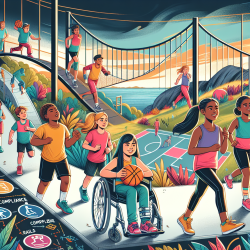Introduction
Engaging youth from under-resourced communities in physical activities is a challenge that educators and community leaders frequently face. A recent review titled Identification of Effective Programs to Improve Access to and Use of Trails among Youth from Under-Resourced Communities: A Review sheds light on how trails can be leveraged to enhance physical activity among youth. This blog aims to provide insights from the review and suggest practical applications for practitioners seeking to implement these findings.
Understanding the Research
The primary purpose of the research was to identify effective programs that increase trail use among youth, particularly those from under-resourced communities. Despite the lack of direct studies, the review highlights correlates of physical activity and trail use, benefits of trail use, and barriers that need to be addressed.
Key Findings
- Correlates of Trail Use: Proximity to trails, access to transportation, and perceptions of safety are significant factors that influence trail use among youth.
- Benefits of Trail Use: Trails provide physical, mental, and social benefits, including improved fitness, reduced stress, and enhanced social interactions.
- Barriers to Trail Use: Cost, crime, lack of transportation, and absence of role models using trails are significant barriers that need to be addressed.
Practical Applications for Practitioners
Practitioners can leverage these findings to design and implement programs that encourage trail use among youth. Here are some strategies:
- Enhance Accessibility: Work with local authorities to improve the connectivity of trails to schools and community centers.
- Promote Safety: Implement measures such as better lighting and community patrols to enhance the safety of trails.
- Role Models: Engage community leaders and local athletes to serve as role models and encourage youth participation in trail activities.
- Community Involvement: Involve parents and community members in planning and executing trail programs to ensure they meet the needs of the youth.
Encouraging Further Research
While the review provides valuable insights, there is a need for more experimental studies to evaluate the effectiveness of trail programs. Practitioners are encouraged to conduct further research and share their findings to contribute to the growing body of knowledge.
Conclusion
Implementing trail programs in under-resourced communities can significantly enhance physical activity among youth. By addressing barriers and leveraging community resources, practitioners can create sustainable programs that promote health and well-being. To read the original research paper, please follow this Identification of Effective Programs to Improve Access to and Use of Trails among Youth from Under-Resourced Communities: A Review.










